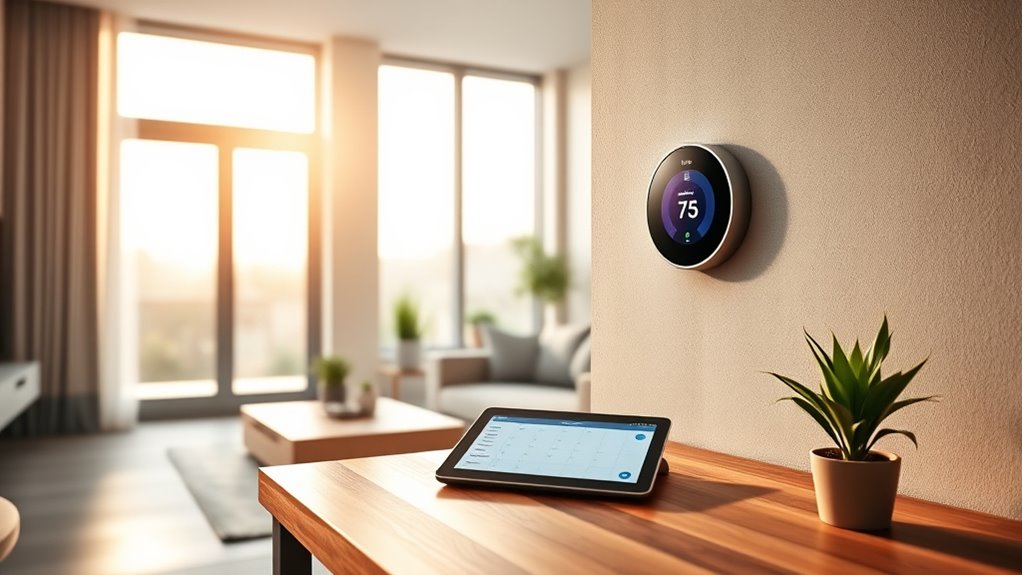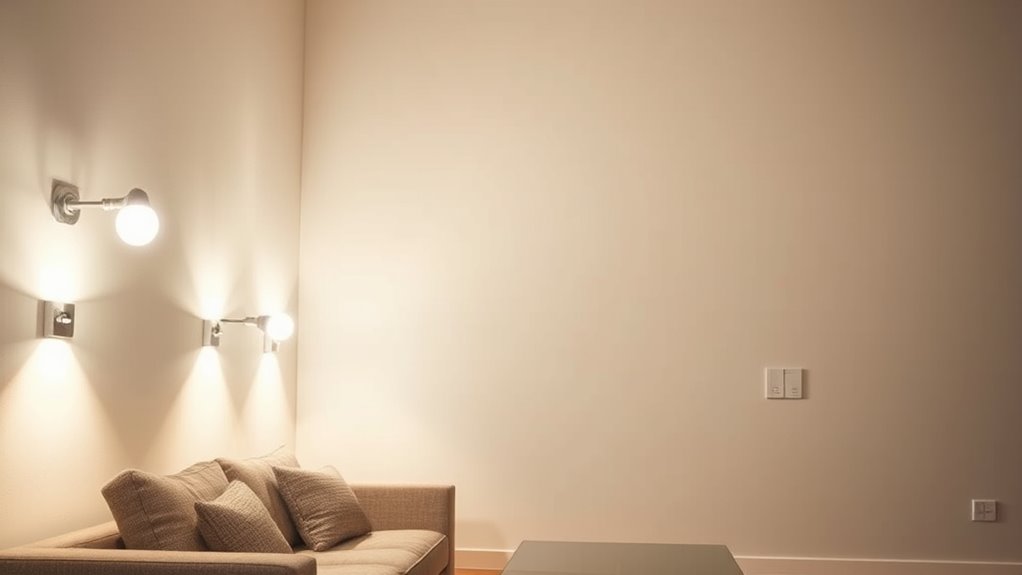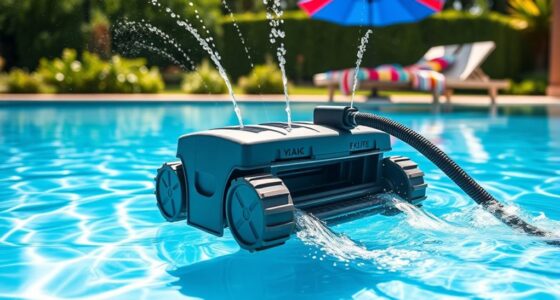To save energy at home, upgrade to high-efficiency appliances and regularly maintain them for ideal performance. Use programmable thermostats to control heating and cooling and seal leaks around windows and doors to improve insulation. Switch to LED lighting and unplug devices when not in use. Consider adding renewable energy sources like solar panels to cut reliance on the grid. Keep exploring practical tips to make your home even more energy-efficient and environmentally friendly.
Key Takeaways
- Upgrade to Energy Star appliances and perform regular maintenance to improve efficiency and reduce energy waste.
- Use programmable thermostats and seal air leaks to optimize heating and cooling, saving energy and costs.
- Switch to LED lighting and unplug devices when not in use to prevent phantom energy drain.
- Install renewable energy sources like solar panels and schedule routine system inspections for optimal performance.
- Incorporate automation and sustainable practices to enhance overall home energy efficiency and environmental impact.
Upgrade to Energy-Efficient Appliances

Upgrading to energy-efficient appliances is one of the simplest ways to reduce your home’s energy consumption. When you choose modern appliances with high Energy Star ratings, you cut down on wasted energy and lower your utility bills. Regular appliance maintenance, like cleaning filters and checking for leaks, ensures they operate at peak efficiency, prolonging their lifespan. These energy-efficient upgrades not only save you money but also lessen your environmental impact. Switching out old refrigerators, washers, and dishwashers for newer models can make a significant difference over time. Remember, maintaining your appliances is just as important as upgrading them—proper upkeep keeps them running smoothly and efficiently. Proper appliance maintenance is essential for maximizing energy savings and extending the lifespan of your appliances. Making these changes helps you create a more sustainable home while saving money in the long run.
Optimize Heating and Cooling Usage

You can conserve energy by using a programmable thermostat to set temperatures when you’re home or away. Sealing air leaks around windows and doors keeps warm or cool air inside, reducing strain on your HVAC system. Regularly maintaining your system guarantees it runs efficiently and prevents costly repairs. Additionally, fostering a creative practice of experimenting with different settings and adjustments can help identify the most efficient ways to manage your energy use.
Use Programmable Thermostats
Have you ever wondered how to reduce energy waste without sacrificing comfort? Using a programmable thermostat is a smart move. Unlike a manual thermostat, it allows you to set temperatures based on your schedule, saving energy when you’re away or asleep. Modern models use temperature sensors to maintain precise comfort levels. For example, you can lower the heat at night and raise it before you wake up, ensuring efficiency and comfort. Setting your thermostat to energy-efficient modes during unoccupied times can further optimize your savings.
Seal Air Leaks
Did you know that sealing air leaks can substantially reduce your home’s energy consumption? Small gaps around windows and doors often cause drafts, making your heating and cooling systems work harder. Fixing window drafts with weatherstripping or caulk keeps warm air inside during winter and cool air during summer. Checking door seals and replacing worn or damaged weatherstripping guarantees a tight fit, preventing air from escaping. Sealing these leaks improves your home’s insulation, which means your HVAC system doesn’t have to run as often or as long. Properly sealing air leaks also contributes to energy efficiency and lowers utility bills. As a result, you save money on energy bills and reduce your carbon footprint. Regularly inspecting and sealing air leaks is a simple, cost-effective way to optimize your home’s energy efficiency year-round.
Maintain HVAC Systems
Regularly maintaining your HVAC system guarantees it runs efficiently and effectively throughout the year. Change filters regularly to improve indoor air quality and prevent dust buildup. Schedule professional duct cleaning to remove debris and ensure unobstructed airflow, which helps your system work less and save energy. Keep vents open and unobstructed to distribute conditioned air evenly. Check thermostat settings to avoid unnecessary heating or cooling, and consider installing a programmable thermostat for better control. Regular inspections can identify issues early, preventing costly repairs and guaranteeing peak performance. Proper maintenance not only reduces energy consumption but also enhances indoor air quality, making your home healthier. Additionally, choosing the right HVAC filters can further optimize system efficiency and air quality. Staying proactive with HVAC upkeep is a simple yet impactful way to save energy and improve comfort year-round.
Incorporate Smart Thermostats and Timers

Smart thermostats and timers help you optimize your home’s temperature settings effortlessly. You can set heating schedules that match your daily routine, saving energy when you’re away or asleep. By automating these adjustments, you’ll reduce waste and lower your energy bills. Monitoring your energy consumption regularly can further enhance your savings by identifying inefficient heating practices.
Optimizing Temperature Settings
To save energy and reduce heating and cooling costs, you should optimize your temperature settings with smart thermostats and timers. Proper thermostat calibration guarantees your system maintains accurate temperatures, preventing energy waste. Temperature zoning allows you to control different areas independently, targeting only occupied spaces and avoiding unnecessary heating or cooling. Set your thermostat to lower settings during sleep or away periods, and raise them when you’re home and active. Regularly review and adjust your settings based on seasonal changes. Using smart thermostats, you can fine-tune your system for maximum efficiency and comfort. Additionally, understanding seasonal energy efficiency ratios (SEER) can help you choose the most efficient systems for your climate.
Automating Heating Schedules
Automating your heating schedule guarantees your home stays comfortable while minimizing energy waste. By using smart thermostats and timers, you can set specific times for your heating system to turn on and off, saving energy when you’re not home or asleep. If you’re comfortable with diy thermostat wiring, you might consider installing a smart thermostat yourself, which often integrates seamlessly with solar heating panels for eco-friendly efficiency. These systems can learn your habits and adjust accordingly, optimizing energy use without constant manual input. Timers can also be used with traditional heating systems for straightforward automation. Incorporating professional installation guidance ensures safety and optimal system performance. Combining these tools helps you avoid unnecessary heating, reduce energy bills, and promote sustainable living—all while maintaining a cozy home environment.
Improve Home Insulation and Sealing

Improving your home’s insulation and sealing is one of the most effective ways to reduce energy waste and lower utility bills. Proper wall insulation keeps warm or cool air inside, reducing the workload on your heating and cooling systems. Additionally, upgrading window treatments can prevent drafts and heat transfer, further enhancing energy efficiency. Sealing gaps around doors, windows, and outlets stops air leaks that compromise insulation. Consider adding weatherstripping or caulking to improve airtightness. Installing reflective window films or heavy curtains can also help control indoor temperatures. These steps create a tighter building envelope, conserving energy and increasing comfort. Remember, small improvements in insulation and sealing can lead to significant savings over time. Effective insulation creates a more consistent indoor temperature and reduces energy consumption.
Switch to LED Lighting

Switching to LED lighting is one of the simplest and most effective ways to cut energy consumption in your home. LED bulbs use substantially less power and last much longer than traditional incandescent bulbs. You can also explore smart lighting options, which allow you to control brightness and schedules remotely, further reducing unnecessary energy use. Pay attention to color temperature when choosing LEDs; warmer tones create cozy atmospheres, while cooler tones are ideal for workspaces. Adjusting the color temperature helps you optimize lighting for different activities and moods, saving energy without sacrificing comfort. Incorporating automation technologies can further enhance energy savings by enabling more precise control of your lighting systems. Making this switch not only lowers your electricity bills but also reduces your carbon footprint, making your home more energy-efficient and environmentally friendly.
Practice Energy-Conscious Habits

Adopting energy-conscious habits amplifies the savings achieved by switching to LED lighting. You can do this by regularly monitoring your energy consumption to identify waste and adjust habits accordingly. Keep up with solar panel maintenance to guarantee maximum efficiency, preventing energy loss. Practice simple habits like unplugging devices when not in use, using programmable thermostats, and minimizing heating or cooling when possible. Track your energy usage over time to spot trends and set realistic goals for reduction. Consider scheduling routine inspections for your solar system to sustain ideal performance. Additionally, be mindful of water heating and appliance use, making small adjustments that add up. Understanding energy-efficient farming techniques can also inspire sustainable practices at home. These practices ensure you stay actively engaged in reducing energy waste and lowering your bills.
Utilize Renewable Energy Sources

Utilizing renewable energy sources is a highly effective way to reduce your home’s reliance on fossil fuels and lower your energy bills. Installing solar panels allows you to harness sunlight, generating clean electricity that cuts costs and benefits the environment. Wind turbines can also provide power if you live in a windy area, transforming breeze into energy. Embracing these options not only saves money but also gives you a sense of contributing to a sustainable future. Consider how these choices impact your family and the planet: Gold IRA Rollovers
Frequently Asked Questions
How Much Can I Realistically Save on Energy Bills Annually?
You can realistically save between 10% to 30% on your energy bills annually, depending on your current usage and improvements you make. Conduct a cost analysis to identify high-consuming appliances and implement energy-saving measures. Your savings estimation will vary, but small changes like switching to energy-efficient bulbs or adjusting your thermostat can add up over time, helping you cut costs and reduce your environmental impact.
Are Energy-Efficient Appliances Worth the Initial Investment?
Imagine your home humming quietly, thanks to energy-efficient appliances that save you money. They’re definitely worth the initial investment because they typically have longer appliance lifespans and lower maintenance costs over time. The upfront cost might seem high, but as you enjoy reduced energy bills and fewer repairs, you’ll see the value. Over years, these appliances pay for themselves, making your home more sustainable and your wallet happier.
What Are the Best Renewable Energy Options for Homes?
You should consider solar panels and wind turbines as the best renewable energy options for your home. Solar panels harness sunlight, reducing your electricity bills and carbon footprint, while wind turbines generate power from wind, especially in windy areas. Both options offer sustainable, long-term savings. You can even combine them for maximum energy independence. Investing in these renewables helps you lower your environmental impact and gain energy resilience.
How Do I Determine the Right Thermostat Settings for Energy Savings?
You can determine the right thermostat settings by using smart thermostats that learn your schedule and adjust temperatures automatically. Set different temperature zones for areas you use most, like living rooms or bedrooms, to optimize energy savings. Keep your thermostat lower in winter and higher in summer when you’re sleeping or away. Regularly review and tweak your settings to maintain comfort while reducing energy consumption effectively.
Can Small Habits Significantly Impact Overall Energy Consumption?
Yes, small habits can substantially impact your overall energy consumption. By being mindful of your lighting habits, like turning off lights when not in use, and managing appliance usage, such as unplugging devices that aren’t in use, you reduce unnecessary energy waste. These small actions add up over time, lowering your energy bills and helping the environment without requiring major changes in your daily routine.
Conclusion
By embracing these energy-saving tips, you’re planting seeds of change that can blossom into a greener, more sustainable home. Think of your efforts as tuning a finely crafted instrument, where each adjustment creates a harmonious balance between comfort and conservation. As you turn the tide toward efficiency, you’re not just saving energy—you’re sculpting a brighter future, one mindful choice at a time. Let your home become a beacon of sustainable living, glowing with purpose and promise.









